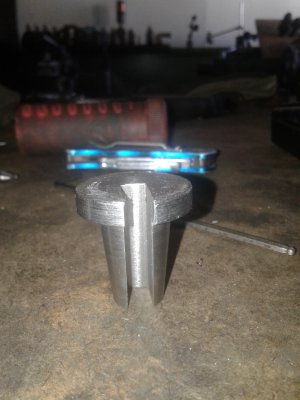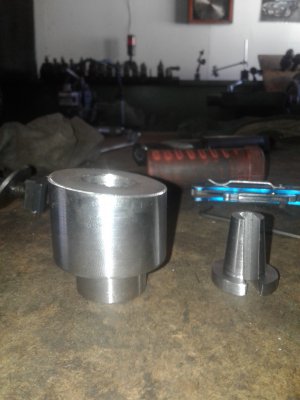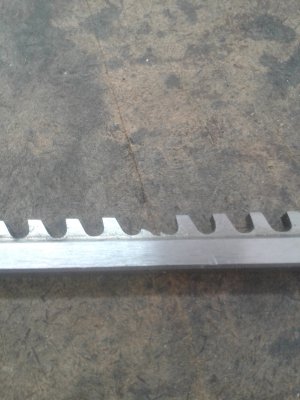- Joined
- Sep 29, 2017
- Messages
- 2,253
I have a problem I can't seem to solve and it is costing me money. I have a client I do quite a lot of flanges with a taper bore and 4mm keyway. Now I use to make the keyway on the lathe withe compound and HSS toolbit,but I didn't like to put so much force on the screw so I got a HSS broach on eBay. Since I haven't done taper bore broaching before, I looked up on YouTube for guidance. So what I found is that I had to make a taper plug to guide the broach. I also made a base with the same angle so when you broach,the broach sits upright and not at an angle.


Now my problem is,I broken two broaches already and I don't understand why. The teeth brakes of around the middle of the broach.

At first I just thought ot was poor quality broaches,but when I inspected the bore after the second breakage, I noticed that somehow the broach takes a much bigger bite at the bottom of the bore than the top at the first pass with the back spacers. And that is way too much for the teeth to handle. So what am I doing wrong? The slot in the plug is at the same angle as the taper of the plug,so according to me the material removal should be the same right through, but that is not happening.
Now I had to go back to the old lathe method just to finish the job. I don't want to buy another broach before I can solve the breakage problem. If someone can shine some light,please do. If I left out anything,please ask any questions to make things clear. Sorry I should have taken more pics with the whole assembly, but I had to get the job out and forgot to take pics.
Please any advice will be appreciated.
Michael


Now my problem is,I broken two broaches already and I don't understand why. The teeth brakes of around the middle of the broach.

At first I just thought ot was poor quality broaches,but when I inspected the bore after the second breakage, I noticed that somehow the broach takes a much bigger bite at the bottom of the bore than the top at the first pass with the back spacers. And that is way too much for the teeth to handle. So what am I doing wrong? The slot in the plug is at the same angle as the taper of the plug,so according to me the material removal should be the same right through, but that is not happening.
Now I had to go back to the old lathe method just to finish the job. I don't want to buy another broach before I can solve the breakage problem. If someone can shine some light,please do. If I left out anything,please ask any questions to make things clear. Sorry I should have taken more pics with the whole assembly, but I had to get the job out and forgot to take pics.
Please any advice will be appreciated.
Michael

